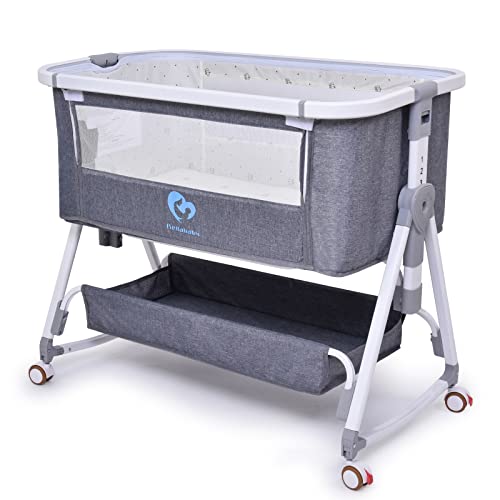The Benefits and Considerations of Bedside Cots for Co-Sleeping
Co-sleeping has become a popular choice for numerous new parents who seek to preserve close distance to their infants throughout the night. Along with traditional co-sleeping practices, bedside cots are acquiring traction as an alternative that provides both the comfort of nearness and the safety of separate sleeping spaces. This short article intends to explore the idea of bedside cots for co-sleeping, highlighting their benefits, potential disadvantages, suggestions for choice, and typical issues.
Understanding Bedside Cots
Bedside cots, also known as side-sleepers or co-sleepers, are specially designed cribs that are attached to the side of the parents' bed. They enable parents to keep easy access to their infants during the night while supplying a different sleeping location that can boost security and comfort.
Functions of Bedside Cots
- Size and Design: Bedside cots are often smaller than standard cribs however still provide adequate room for an infant. Most models have adjustable heights to match the bed.
- Side Panels: Many designs include removable or mesh side panels that permit safe visual monitoring of the baby, enhancing parents' capability to react to their baby's requirements rapidly.
- Stability and Safety: Bedside cots are constructed with stability in mind, including safety anchors or straps that protect the cot to the moms and dad's bed.
- Ease of Access: Parents can easily reach over to comfort or feed their baby without having to rise, helping with nighttime breastfeeding or soothing.
Benefits of Using Bedside Cots for Co-Sleeping
- Improved Bonding: Proximity to the baby cultivates psychological connection and bonding, which is crucial throughout the early phases of development.
- Easier Nighttime Care: Nighttime feeding and soothing ended up being significantly easier with a bedside cot, as parents can simply lean over to address their baby's requirements.
- Increased Safety: Bedside cots minimize the threat of suffocation or unintentional rolls that can accompany traditional co-sleeping straight in the adult bed.
- Individual Sleep Space: The documents supports that having their own sleeping space can assist infants sleep much better in terms of fewer disruptions from parents.
- Transitioning: A bedside cot can be a practical transitional tool as babies grow and begin to relocate to their own spaces.
| Function | Benefits |
|---|---|
| Boosted Bonding | Closer physical presence |
| Easier Access | Quick action to requirements |
| Increased Safety | Reduced danger of accidents |
| Individual Space | Less disruption at night |
| Streamlined Transition | Much easier transfer to independent sleeping |
Considerations Before Choosing a Bedside Cot
While bedside cots use various benefits, prospective users must consider the list below factors:
- Size of Bed: Ensure that the cot fits nearby to the bed without causing discomfort or overcrowding.
- Budget: Prices can differ substantially amongst different brands and designs, so consider spending plan restrictions thoroughly.
- Security Standards: Check that the cot meets all safety policies to guarantee it is devoid of dangerous materials and includes necessary safety functions.
- Product: Non-toxic surfaces and materials are most importantly important for infant health.
- Infant's Age and Weight: Some cots have weight limitations, and parents must select accordingly based on their baby's development.
Tips for Selecting a Bedside Cot
- Check out Reviews: Look for user feedback and safety ratings.
- Look for Certifications: Ensure the cot abides by security standards.
- Inspect the Design: Choose a design that complements your bedroom style while ensuring performance.
- Consider Accessibility: Look for models that permit easy reach however decrease the danger of presenting.
- Test Stability: Ensure that the cot is steady and secure when connected to the bed.
Typical FAQs About Bedside Cots for Co-Sleeping
Q1: Are bedside cots safe for co-sleeping?
A1: When used correctly, bedside cots are designed to provide a safe sleeping alternative for infants while enabling close proximity to parents. Always ensure to secure the cot properly to prevent motions that could cause accidents.
Q2: At what age can I start using a bedside cot?A2: Many parents begin utilizing bedside cots right after the baby is born. However, Bedside Cot For Convenient Access is important to seek advice from a healthcare service provider concerning your infant's preparedness for co-sleeping, especially if they were born prematurely. Q3: Can I use a routine
crib for co-sleeping? A3: While routine cribs can be used, they do not offer the very same level of ease of access and safety as bedside cots, making bedside alternatives more favorable for co-sleeping. Q4: What if my baby rolls over?A4: Most bedside cots are developed with security features that minimize dangers if a baby rolls. Furthermore,
they are normally low enough that a roll would not result in a substantial drop. Q5: How do I transition my baby from a bedside cot to a regular crib?A5: Gradually move your baby to a different crib in their own room after they become familiar with sleeping in the bedside cot. Start with naps in the crib while preserving nighttime co-sleeping until they adapt. Bedside cots present a useful and much safer option to direct co-sleeping, supplying many benefits in terms of convenience and security. They help with bonding
between infants and parents while lessening the dangers connected with standard co-sleeping practices. Parents looking for a way to keep their babies close during the night must think about the benefits that bedside cots can use. With a cautious examination of options readily available, parents can produce a safe and comfortable sleep environment that supports their family's unique needs.

